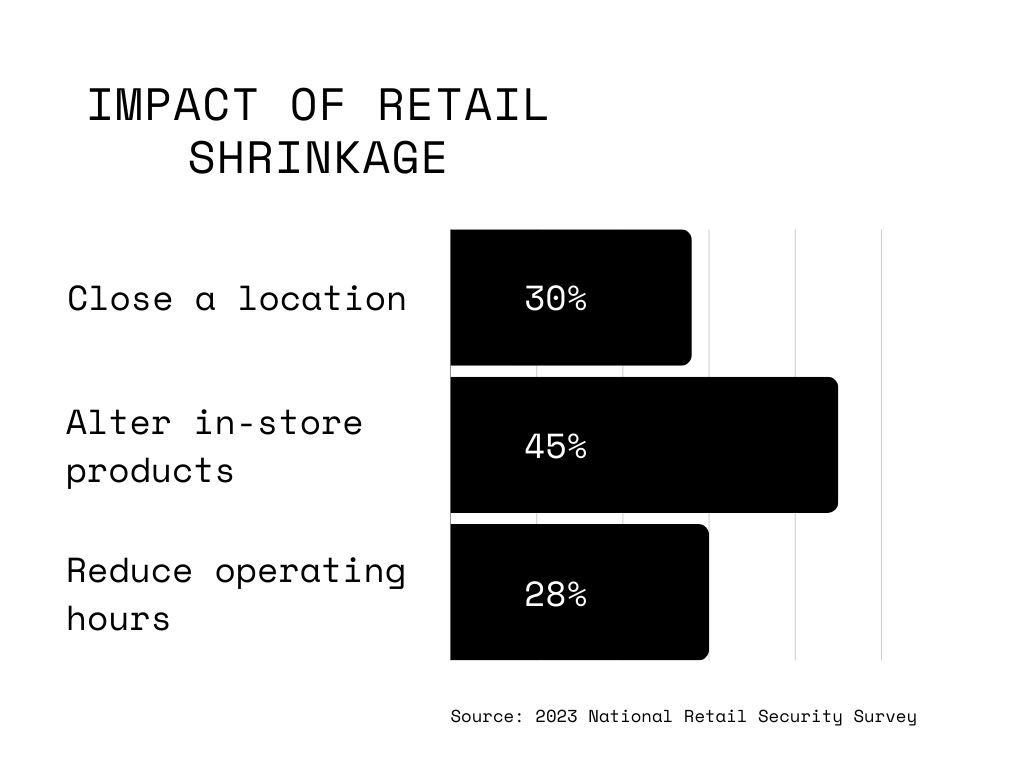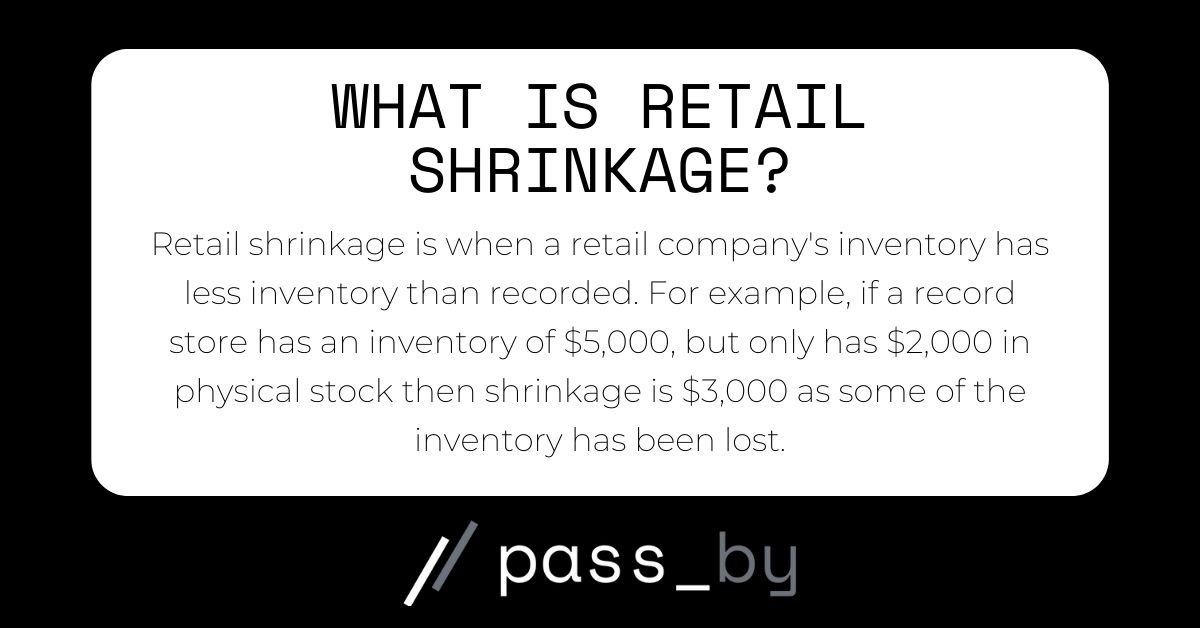What is retail shrinkage?
Retail shrinkage is when a retail company’s inventory has less inventory than recorded. For example, if a record store has an inventory of $5,000, but only has $2,000 in physical stock then shrinkage is $3,000 as some of the inventory has been lost.
Retail inventory shrinkage costs the retail industry $46.8 billion. That’s about 1.33 percent of sales, on average according to a survey from the National Retail Federation (NRF).
The average retail shrinkage percentage is 1.44 percent as of 2021 according to NRF.
When inventory is lost through shrinkage, it directly hits a retailer’s profits. Retailers with high shrinkage rates can carry costs over to customers, who have to pay higher prices to make up for shrinkage losses.
Types of shrinkage in retail and how to prevent them
Discrepancy between a company’s documented inventory and its actual, physical stock can occur as a result of numerous factors. The most common types of shrinkage in retail are:
- Employee theft: Ranges from an employee stealing a single piece of merchandise to more complex schemes involving fraudulent transactions or manipulating the inventory system.
- Shoplifting: Opportunistic or organized theft in brick-and-mortar stores.
- Administrative errors: Unintentional errors in record-keeping, mislabeling of products, etc.
- Vendor fraud: A supplier or vendor fails to deliver the entire order, delivers damaged products, or incorrectly bills for undelivered products. All these factors contribute to retail shrinkage. To tackle it, retailers must first identify the shrinkage types they face as each type has different causes and solutions.
Employee theft
Employee theft, also referred to as ‘internal theft’, is an unfortunate yet common factor of retail shrinkage. It involves instances where company employees purposefully take goods, and cash or misuse services without permission.
You might be surprised by some of the facts. 37.5% of employees have stolen at least twice from their employer. Once an employee steals from you, they are likely to do it again.
Retail shrinkage caused by internal theft can appear as the outright stealing of goods to complex schemes involving refund and discount fraud.
How to prevent employee theft
- Strict hiring and background checks: While not foolproof, checks can help to ensure that employees are trustworthy before they are hired.
- Employee training: Conduct regular training sessions to clarify what constitutes theft and the consequences associated with it. This can serve as a deterrent to potential employee thieves.
- Clear company policies: Clearly articulate and enforce company policies regarding theft. This includes clearly communicating the consequences of theft to all employees.
- Internal controls: Establish robust internal controls and checks to limit the opportunity for employee theft. This may include separating duties so that no single employee has control over all parts of a transaction.
- Audit: Regularly audit inventory and cash handling procedures. Audits can help spot discrepancies early and mitigate potential theft.
- Reward programs: Encourage staff to report suspicious activities by implementing reward programs.
- Open-door policy: Employ an open-door policy where any employee with concerns or knowledge of possible theft can confidentially report to management.
- Surveillance equipment: While ensuring the privacy rights of employees, use surveillance cameras and security systems as a deterrent against theft.
Shoplifting
You might believe that shoplifting isn’t a major concern in the world of retail shrinkage. However, you’d be surprised to learn that it’s indeed a significant issue for many retailers. It’s not just a few inconsequential items being swiped here and there. Together, several seemingly minor incidents can accumulate into an astounding quantity of goods.
Shoplifting makes up a substantial proportion of total retail shrinkage, and might be further complicated by the involvement of professional theft rings. Professional thieves are known to commit thefts on a much larger scale, often targeting high-value items and exploiting security weak points to carry out their illicit activities.
Often, the motivation for shoplifting can range from financial difficulties to impulsive behavior or even the thrill of stealing. Regardless of the reason, the ultimate impact is on the profitability and viability of the store. Each item stolen represents a direct loss in revenue, and when the numbers start adding up, it can have a profound effect on a store’s bottom line.
How to prevent shoplifting
A retailer’s defense against shoplifting varies as much as the motives for it. Retailers often employ a mix of visible and covert security measures to deter shoplifters.
- Visual deterrents: Install mirrors, use CCTV cameras, and maintain good lighting to discourage potential shoplifters.
- Effective store layout: Design your store in a way that discourages shoplifting, such as placing expensive items near checkouts or in clear sight.
- Excellent customer service: A friendly and attentive store team that frequently interacts with customers can deter shoplifters.
- Invest in theft prevention technology: Consider using anti-shoplifting devices like security tags, alarm systems, and anti-theft scanners.
- Enforce strict bag check policies: Implement strict entrance and exit procedures, including bag checks, to discourage theft.
- Training staff: Regularly train your employees on the signs of shoplifting and how to handle suspicious behaviour.
Administrative errors
Administrative errors can take various forms, including simple mistakes in shipment paperwork, incorrect pricing, and sales recording mistakes. The errors can easily go unnoticed for an extended period, silently eating up your profits.
For example, invoice errors where vendors may bill for items never delivered or under quality. Over time, these incorrect charges add up and create a significant dent in your revenue, presenting itself as shrinkage.
Similarly, data entry errors, like recording $10 as $100, misplacing a decimal, or updating the inventory incorrectly, might seem trivial but overtime compound into major shrinkage.
How to prevent administrative errors
- Implementing proper checks and balances: Make sure you have a system in place that requires multiple people to approve transactions, which can prevent costly mistakes.
- Investing in staff training: Invest in regular staff training so that employees understand company procedures and can properly handle transactions.
- Prioritizing organization: Ensure your record-keeping is thorough and organized. A simple filing mistake can result in lost resources.
- Using modern tech tools: Make use of automated systems to process transactions, manage inventory, and track sales. These systems can significantly reduce errors.
- Conducting regular auditing: Regular audits can help identify discrepancies and prevent administrative errors from turning into significant losses.
- Establishing clear policies: Clear, documented policies for handling common tasks such as refunds or exchanges can minimize mistakes and misunderstandings.
Vendor fraud
Let’s dive a little deeper into vendor fraud – one of the less obvious, but equally damaging, types of shrinkage in retail.
Vendor fraud typically transpires when an external supplier or vendor deceitfully exploits a retail business, causing it to lose inventory, revenue, or both.
This fraudulent activity can manifest in several ways, including invoice fraud, return fraud, and product substitution, among others.
Invoice fraud occurs when vendors charge more than what has been delivered or agreed upon, perhaps by overstating the costs or quantities, or even by issuing false invoices for items that were never supplied.
Return fraud, on the other hand, takes place when counterfeit or substandard goods are returned, instead of the original items. In instances of product substitution, unscrupulous vendors deliver less expensive items in place of those that were ordered, benefiting from the price difference.
How to prevent vendor fraud
- Due diligence: Before partnering with a vendor, carry out exhaustive background checks. Understand their business model, their reputation in the industry, and any potential red flags in their financial history.
- Contracts: Create clear, straightforward contracts with vendors. Clearly outline all responsibilities, standards, payment terms and include all potential contingencies.
- Regular audits: Implement regular audits on your vendor’s billing and shipping accuracy. This process will help detect inconsistencies early on and prevent potential fraud.
- Relationship building: Establishing a good, transparent relationship with your vendor can encourage them to stay honest. Foster open communication and build a culture of trust and integrity.
- Vendor policies: Clearly communicate your company’s policies on bribery and corruption to all vendors. Ensure they understand the legal and ethical expectations of doing business with your company.
What is organized retail theft?
Organized retail theft is no petty crime. Organized theft is orchestrated by professional thieves, who misappropriate goods on a grand scale, resulting in significant financial losses and retail shrinkage.
“The San Francisco Police Department just received a $15.3 million organized retail theft grant,” William Scott, Chief of Police for the San Francisco Police Department.
The very fund granted to the San Francisco Police Department is aimed to specifically counter these challenges – and many police departments across the States are tackling similar issues.
Viral videos such as this one have captured examples of thieves stealing display iphones to sell on the black market.
What is the impact of retail shrinkage?

The 2023 National Retail Security Survey found that retailers take strong action because of retail shrinkage, namely theft. Retailers often choose to close a location (30%), alter in-store products (45%), or reduce store operating hours (28%). Many of these strategies, while effective, can have a negative impact on the business, employees, and customers.
How to prevent shrinkage in retail
There are many types of shrinkage in retail and each one has different, effective strategies you can use to reduce or prevent it. These are some of the strategies you can use in combination:
- Implement strict accounting
- Prescreen and background check new hires
- Install security systems
- Consider a loss control manager
- Optimize inventory management
Implement strict accounting
Accounting is the language of your business. When it’s fluent, accurate, and efficient, you get a clear picture of your financial health, including areas where you might be experiencing loss, like shrinkage.
A strict accounting system allows for the monitoring of all transactions meticulously. Each sale, return, and supplier delivery should be accurately recorded. Regular audits should also be performed to reconcile recorded sales with bank deposits and inventory levels.
Tools such as Point Of Sale (POS) systems can aid in maintaining proper records, expedite regular audit processes, and automate some of the more tedious aspects of accounting. Just like an extra pair of eyes, these sophisticated systems help in identifying anomalies quickly and accurately. Let technology help you!
Prescreen and background check new hires
Fostering a trustworthy and reliable workforce can initiate from the hiring process itself. To help minimize the risk of employee theft, one critical step is conducting comprehensive prescreening and background checks for new hires. It’s not about invading someone’s privacy, but rather ensuring they have the integrity, honesty, and trustworthiness that align with your organization’s values.
Performing thorough background checks can reveal significant information including past criminal activities, discrepancies in employment history, falsified references, or poor credit history which can indicate potential risk factors. But remember, this is not just about mitigating risks, it’s also about hiring the right people who can contribute positively to your business.
In conclusion, by investing in thorough and continuous prescreening and background checks, you can foster a safer environment within your retail establishment, lessen retail shrinkage resulting from employee theft, and establish a workforce that is trustworthy and reliable.
Install security systems

There’s no denying the significance of robust security systems in curbing retail shrinkage. Installing high-quality security equipment such as surveillance cameras, intrusion detection systems, or alarm systems can dramatically deter theft which is a major type of retail shrinkage.
For instance, surveillance cameras not only record illicit activities, but their mere presence often discourages thieves. They also provide visual evidence that can aid in resolving disputes and can be used in investigations.
Choosing the right security system often depends on the store’s size, layout, and the type and value of the merchandise sold. It’s crucial to tailor the security mechanisms to the specific needs and context of your business. It’s also important to regularly review and update these systems following advancements in technology and changes in store layout or inventory.
Consider a loss control manager
As the complexity of your retail operation grows, it might be beneficial for you to consider hiring a loss control manager. This is a specialized role that focuses solely on combating retail shrinkage, and it could be a game-changer for your business.
A loss control manager is responsible for developing and implementing processes, programs, and procedures to reduce retail shrinkage. They typically work closely with other managers and staff to ensure everyone is educated about, and involved in, loss prevention. This might include conducting training and awareness programs that inform staff about various types of shrinkage, and the best practices to prevent them.
A loss control manager usually oversees inventory audits and regularly checks surveillance footage for any suspicious activities. They also serve as the point person when dealing with law enforcement or security services and coordinating investigations into theft incidents.
Knowledge is your first line of defense against shrinkage and a loss control manager can provide you with that. They ensure your organization’s strategies are up-to-date and effective, giving you peace of mind and enabling you to focus more on advancing your business.
Optimize inventory management
A well-managed inventory system will help you keep track of your stock movements, so it’s crucial to ensure that your inventory management process is as efficient as possible. It’s all about getting the right amounts of the right products onto the right shelves at the right time.
Inventory audits, if done frequently, can help in detecting the problems before they are too far gone.
Another great tool is inventory management software. These platforms help automate a large part of the inventory process. They can also integrate with other software, like point-of-sale (POS) or warehouse systems, to provide a holistic view of your retail process. Systems like these can help track sales, automate reorders, or even anticipate sales trends.
Preventing retail shrinkage by optimizing your store
Efficient management and robust systems are key in identifying and preventing employee theft. Monitoring measures like surveillance cameras, regular audits and effective inventory control play a significant role in curbing this type of shrinkage.
You can also use competitive business intelligence to see how your competitors are combating shrinkage for ideas.
But remember, fostering a respectful work environment and encouraging employee loyalty often goes hand in hand with mitigation strategies. After all, happy employees are less likely to engage in harmful behaviour that hurts their workplace.
Retail shrinkage FAQs
What are the most common types of shrinkage in retail?
The most common types of shrinkage in retail are employee theft, shoplifting, administrative errors, and vendor fraud.
How much shrinkage is common in retail?
The 2022 Retail Security Survey found that the average retail shrink rate across the industry is 1.4% which has remained steady for the last five years. If your shrinkage rate is higher than average, it’s time to look at your loss prevention strategies.
How is shrinkage calculated in retail?
In retail, shrinkage represents the discrepancy between the recorded inventory value and the actual inventory you have on hand. This difference is expressed as a percentage of total sales and highlights the merchandise lost due to factors such as theft, damage, or errors.





